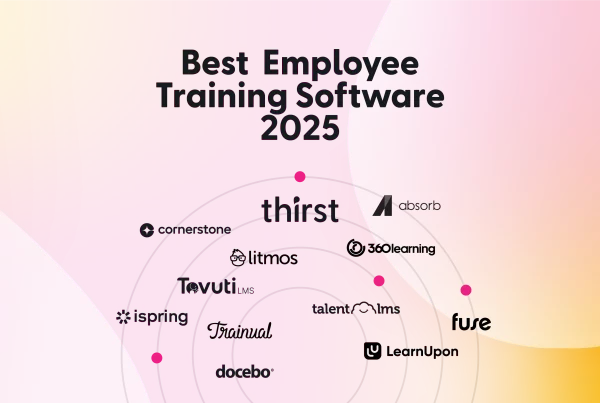89% of UK employers believe continuous learning to be paramount in the workplace. 🔄
At least according to a 2021 study. Employees should be ready to learn new skills or even retrain in new areas to add real value to their role and their employer.
These findings should be nothing new to anyone.
Just look at the rapid increase of digital technology in the last two decades.
From Microsoft Office to Chat GBT, you’d be hard-pressed to find any roles that don’t ask employees to leverage digital technology to some extent.
A continuous learning culture is at the core of who we are as people. Our vocations. If only to make sure that employers have talent with aptitudes to meet the evolving demands of their roles. 😆
It makes sense, right?
After all, it’s impossible for any organisation to excel without capable individuals who have access to and the ability to leverage L&D to seamlessly learn new skills. L&D is the foundation on which continuous learning is built.
Let’s look at this idea in a little more detail.👇
What is continuous learning?
It’s not rocket science to understand continuous learning.
Although rocket science has a fair amount of continuous learning, It’s all about a person’s ongoing commitment to L&D. To acquire more knowledge. Skills. To be better than you were last year, last week, heck even yesterday.
Continuous learning is an umbrella term.
One that transcends a wide range of learning. It’s basically consistently developing valuable skills to meet the demands of your environment.
It’s L&D in the workplace. It’s educational qualifications. It’s the hundred hours spent perfecting Chopin’s Etude, Op. 10 No. 4.
This requires strong self-motivation. dedication to excel. A willingness to sacrifice time.
It’s the ambition to be better.
Not necessarily the best—that’s reserved for a select few hyper-ambitious people—it’s the desire to hone one’s skills. To be the best that you can be.
Why is continuous learning important?
Workplaces evolve. Oftentimes quicker than you may think.
Look at digital marketing. Google updates its algorithm 500–600 times a year to improve search results and the user experience.🤯
That’s a lot! Between one and two updates a day. Most of these updates don’t affect the SEO landscape. But some do. Core Update. Panda. Penguin. Businesses needed to adapt their digital marketing to remain competitive. 💻
Why mention this?
To illustrate that the modern commercial world evolves. Sometimes quicker than we’re ready for. Continuous learning is the key to continuing prosperity.
But it’s not just evolving technologies that present a challenge to organisations.
There’s demographics. Regulations. Legislation. Job markets.
They’re all subject to change.
To succeed in such a rapidly changing environment, organisations need to adapt.
One way to do this is to invest in people and adopt a continuous learning culture.
Optimise employee performance. Identify knowledge gaps and implement appropriate L&D.
Equip your organisation for the challenges you face and those to come. This will empower them. And power your organisation for continued prosperity. 🙌
Examples of continuous learning
Continuous learning should be a focal point for both our personal and professional development.
We all face challenges daily. And have done since the dawn of mankind. It’s part of the human experience. Growing up. Being an adult.
Sure, we’re no longer hunter-gatherers, having to scavenge for food to survive, living in caves and makeshift shelters to protect us from the outside, but that spirit of continuous learning, to be better than before, is, in many ways, what defines the human experience.
Our adaptability—how we can pivot our actions to any change in the environment and new developments—is one of our greatest assets. This continual learning is prevalent in the workplace and is demonstrated in many ways. 💡
✅ Individual and group continuous learning
Organisations have to adapt to environmental changes. Both internal (within the organisation) and external (sectorial, economic, commercial, or cultural.) This adaptability is often spearheaded by individuals, although collective, group commitment spearheads success.
On an individual level, this can include something as simple as asking for help when completing workflows to thinking outside the box to uncover more efficient ways of, for example, chasing invoices.
In a group setting, continuous learning might include leveraging an AI-powered platform, like Thirst, to accelerate learning culture, talent acquisition, leadership development, and internal mobility.
✅ L&D will promote business sustainability
Invest in people, and you’ll develop a culture of continued success. Why? Investing in people makes them feel empowered and valued, promotes stability, and increases retention rates. It’s more sustainable to upskill employees than it is to continually outsource talent to fill roles. ☺️
Today’s organisations tend to focus on maintaining a strong workforce to meet ever-changing organizational needs. This means promoting from within. This fosters sustainability, security, and trust while keeping employees motivated to add more strings (skills) to their bow. Also, continuous learning signals to employees that they’re worth investing in.
✅ Social learning and continuous learning
Facebook. LinkedIn. Twitter, or, as it’s now called, X. Instagram. Social media has thrust itself into the forefront of our personal and professional lives. It’s how we communicate. Motivate. Share ideas. Learn. Grow.
Spend any time at all on social media, and you’ll have the opportunity to learn. Now, of course, we’re not talking about cat videos or family pictures. We’re talking about checking our feeds. Joining groups. Sharing comments. Liking posts. 📱🧑💼
Best of all, it doesn’t feel like learning. It feels like learning. It feels like networking. Learning is just a bonus. If you want to learn what respected figureheads in the L&D space are saying and continue your own learning, you only need to check out social media.
Then there’s learning by socialising. Or social learning theory.
In a nutshell, social learning is knowledge and behaviour acquired by interacting with other people. Think about all the conversations you have in the workplace. How often do you learn something new? We’re guessing quite often.
This is the social learning in action. 🙏
Benefits of continuous learning for L&D
By now, you have probably assumed correctly that there are several core benefits organisations can reap when they invest in L&D. Let’s look at each below.
✅ Competence leads to confidence
The better someone is at something, the more confident they are. This is true of driving, drawing, calculating, critiquing, and just about anything! Continuous learning helps individuals and businesses to continually improve and gain a broader understanding of their role, while also helping them gain greater insight.
Any newly found aptitude allows individuals—and organisations—to consider new, more innovative ways of doing things. This often streamlines actions while boosting engagement and improving overall job satisfaction. Employees have a sense of purpose. Feel passionate about the organisation and your role in it. Are psychologically attached to their role and employer.
✅ Improved performance
Motivated people perform better. Passionate and purposeful people are motivated people. The natural consequence of this is improved performance. Organisations that have mastered employee engagement will reap the benefits.
According to Forbes, highly engaged teams report a 59% reduction in staff turnover. They also report a 41% reduction in absenteeism. This amounts to a 21% increase in profitability. 🔥
What’s the key to improved performance? A continuous learning culture.
✅ Better customer experiences
Productive employees who are engaged, motivated, and generally perform to the best of their ability will automatically provide a better customer experience than disinterested and unmotivated employees. Research has shown that organisations with engaged, motivated, and high-performing employees provide a customer experience 150% better than organisations that don’t. 🙌
Whereas a single successful customer interaction doesn’t automatically equal increased revenue, it will bolster your business’s reputation, which may lead to more prospects, customers, and advocates.
In today’s competitive working environment, one of the key success factors is customer experience. 73% of customers will switch to a competitor after multiple bad experiences. 🤔
Continuous learning is essential to optimising the customer experience. This could be L&D training, learning from a particular experience, or even listening to how a colleague dealt with a challenging customer.
What’s certain, however, is that when customers are pleased with their customer experience, they’re more likely to become advocates, strengthening your company’s market foothold.
✅ Any knowledge acquired is more likely to be retained
When learning anything new, repetition is the key. This is about the last time you learned how to use a new CRM. Did you master it the first time? We doubt it. Most everyone learns by repeating actions. Again. And again.
Why is this so? Repeated actions at intervals are essential to committing new skills to memory. If retained information isn’t reviewed at least periodically, most of us will forget it.
Can you tell us the equation used to calculate kinetic energy that you learned for your GCSE Physics exam? 🤔
✅ Increased employee loyalty
Psychological ties to an organisation. The satisfaction of confidence. Learning a new skill. Employees who feel one or all of these are less likely to actively seek out new job opportunities.
Employee retention is a BIG deal!
Especially the retention of your top-performing employees.
They are the ones who spearhead departments. Who motivates others to complete any L&D? Who helps to increase productivity and profitability?
Disengaged employees can be turned into brand advocates.
All it takes is a shift in ethos. In operations. A little recognition here. Instilling trust there. Maybe an investment in L&D will help underperforming employees gain more confidence.
Invest in a culture of continual learning, and you may just find that your employee retention rates drastically improve.
How to create a continuous learning culture
L&D can be a key differentiator, a motivator for attracting stellar candidates to your organisation and building an infrastructure for success.
But how can organisations create a culture of continuous learning? Find out more below.
✅ Top-down approach
Creating a culture of continuous learning starts at the top. The senior decision-makers should spearhead a culture that promotes workplace learning evolution.
When colleagues see that their supervisor, manager, or director fully embraces a commitment to L&D, this creates a continual learning ethos. Why not schedule L&D time each month for every employee? You might see their enthusiasm and their performance skyrocket.
✅ Leverage subject-matter experts
Apart from getting employee buy-in, the key aspect of promoting a learning culture is to make any L&D engaging and insightful.
To do this, you need to leverage subject-matter experts within your organisation. 🧑🏫
There’s also an added bonus to this: employees who share their knowledge and contribute to the betterment of their working environment, feel empowered and valued, and it also helps to cultivate a supportive learning environment.
✅ Champion decentralised learning experiences
Centralised learning can be very valuable in some learning environments. The problem is that this learning approach doesn’t support a continuous learning culture.
By choosing a decentralised approach, one that makes use of learning tools like LXP, while encouraging colleagues to learn at a time and in an environment that suits them, highlighting self-directed learning, organisations empower employees to excel in all aspects of their learning.
✅ Invest in a learning platform
In today’s modern working environment, it has never been more important to leverage learning platforms to support continuous L&D—when it’s important to employees.
A modern LXP like Thirst, for instance, is the best way to accentuate organisation-wide learning and development.
From managing the L&D lifecycle to providing access to resources and even promoting mobile learning, invest in a learning platform, and you’ll take your organisation’s L&D to the next level. Thirst can help you with that! 🖥️
✅ Foster a collaborative learning approach
There are few better ways to accelerate learning than by fostering a collaborative learning approach. This reinforces L&D while propelling participants to remain engaged throughout the process.
Also, collaborative learning encourages continuous iteration. Evolution. This can help organisations better optimise the learning experience, bolster engagement, and improve course completion rates. 🧑🤝🧑
Continuous learning is vital
There’s a strong argument to be made that the key to success is continuous lifelong learning. In life and in the workplace. Think about how many successful people you can name who aren’t committed to learning. Can you think of any?
Implement this ethos in the workplace, and you’ll foster a culture of learned, ambitious, dedicated, and collaborative colleagues. This will propel your organisation to be the very best it can be.
Make it easy for employees to voice their L&D needs. Give them access to the resources they need to excel. Create a collaborative and fun learning environment. Implement a consistent feedback loop to hone the learning experience and understand what people need. Foster a shared connection. Leverage an LXP.
Do this, and you’ll promote continuous learning and reap the benefits.
For more L&D insights, including resources, insights, news, and the future of L&D, be sure to read the Thirst blog. 👌
For more e-learning insights, resources and information, discover the Thirst blog.
You may also enjoy:
7 Ways to Boost Your Learner Engagement | 10 Ways to Overcome the Forgetting Curve | Communication Styles: The 7 Most Common and How to Find Yours







